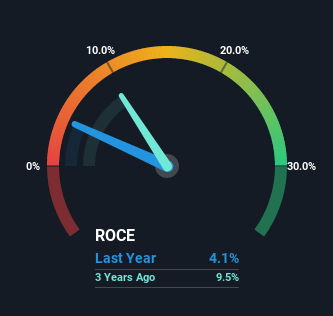- Denmark
- /
- Renewable Energy
- /
- CPSE:ORSTED
Here's What's Concerning About Ørsted's (CPH:ORSTED) Returns On Capital

Finding a business that has the potential to grow substantially is not easy, but it is possible if we look at a few key financial metrics. In a perfect world, we'd like to see a company investing more capital into its business and ideally the returns earned from that capital are also increasing. If you see this, it typically means it's a company with a great business model and plenty of profitable reinvestment opportunities. Although, when we looked at Ørsted (CPH:ORSTED), it didn't seem to tick all of these boxes.
What Is Return On Capital Employed (ROCE)?
For those who don't know, ROCE is a measure of a company's yearly pre-tax profit (its return), relative to the capital employed in the business. To calculate this metric for Ørsted, this is the formula:
Return on Capital Employed = Earnings Before Interest and Tax (EBIT) ÷ (Total Assets - Current Liabilities)
0.041 = kr.10b ÷ (kr.307b - kr.55b) (Based on the trailing twelve months to March 2023).
Therefore, Ørsted has an ROCE of 4.1%. Ultimately, that's a low return and it under-performs the Electric Utilities industry average of 8.6%.
See our latest analysis for Ørsted

Above you can see how the current ROCE for Ørsted compares to its prior returns on capital, but there's only so much you can tell from the past. If you'd like to see what analysts are forecasting going forward, you should check out our free report for Ørsted.
SWOT Analysis for Ørsted
- Debt is not viewed as a risk.
- Earnings declined over the past year.
- Dividend is low compared to the top 25% of dividend payers in the Electric Utilities market.
- Current share price is above our estimate of fair value.
- Annual earnings are forecast to grow faster than the Danish market.
- Paying a dividend but company has no free cash flows.
- Annual revenue is forecast to grow slower than the Danish market.
What Does the ROCE Trend For Ørsted Tell Us?
On the surface, the trend of ROCE at Ørsted doesn't inspire confidence. Over the last five years, returns on capital have decreased to 4.1% from 6.6% five years ago. Although, given both revenue and the amount of assets employed in the business have increased, it could suggest the company is investing in growth, and the extra capital has led to a short-term reduction in ROCE. And if the increased capital generates additional returns, the business, and thus shareholders, will benefit in the long run.
In Conclusion...
While returns have fallen for Ørsted in recent times, we're encouraged to see that sales are growing and that the business is reinvesting in its operations. And the stock has followed suit returning a meaningful 71% to shareholders over the last five years. So while investors seem to be recognizing these promising trends, we would look further into this stock to make sure the other metrics justify the positive view.
On a final note, we found 3 warning signs for Ørsted (1 can't be ignored) you should be aware of.
While Ørsted isn't earning the highest return, check out this free list of companies that are earning high returns on equity with solid balance sheets.
Valuation is complex, but we're here to simplify it.
Discover if Ørsted might be undervalued or overvalued with our detailed analysis, featuring fair value estimates, potential risks, dividends, insider trades, and its financial condition.
Access Free AnalysisHave feedback on this article? Concerned about the content? Get in touch with us directly. Alternatively, email editorial-team (at) simplywallst.com.
This article by Simply Wall St is general in nature. We provide commentary based on historical data and analyst forecasts only using an unbiased methodology and our articles are not intended to be financial advice. It does not constitute a recommendation to buy or sell any stock, and does not take account of your objectives, or your financial situation. We aim to bring you long-term focused analysis driven by fundamental data. Note that our analysis may not factor in the latest price-sensitive company announcements or qualitative material. Simply Wall St has no position in any stocks mentioned.
About CPSE:ORSTED
Ørsted
Owns, develops, constructs, and operates offshore and onshore wind farms, solar farms, energy storage and renewable hydrogen facilities, and bioenergy plants.
Moderate growth potential and slightly overvalued.
Similar Companies
Market Insights
Community Narratives



